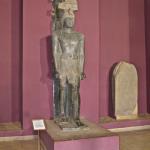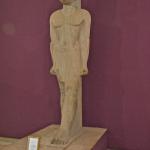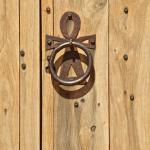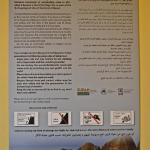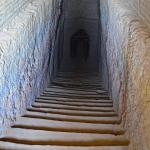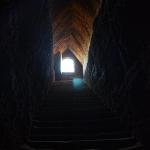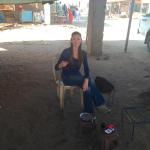© 2011 Sabrina Swenson. All Rights Reserved.
Sudan
February, 2017
On January 27th, 2017 President Trump signed an executive order blocking entry into the US for 90 days, the citizens of seven predominantly Muslim countries. Inconveniently, Sudan was on that list and that's exactly where I was headed five days later.
Upon arrival at Sudan's capital airport, Khartoum, I wasn't sure if I'd be allowed in. If the Sudanese government felt like reciprocating a ban on Americans coming into their country, I could have very well been denied entry. Fortunate for me and my travel plans, the Sudanese allowed me in with no delay what-so-ever.
The Republic of the Sudan is the third largest country in Africa. It's sometimes referred to as North Sudan since South Sudan's independence. Before the Sudanese civil war, South Sudan was part of Sudan. It broke away in 2011 becoming the youngest country in the world to date. The second Sudanese civil war was a conflict from 1983 to 2005 between the central Sudanese government and the Sudan People's Liberation Army. It was largely a continuation of the first Sudanese civil war of 1955 to 1972. The second Sudanese civil war lasted 22 years and is one of the longest civil wars on record. The war resulted in the independence of South Sudan six years after the war ended. Unfortunately, in 2013 civil war erupted once again in South Sudan and continues today.
After arriving in the capital, I found an inexpensive hotel for the night and then walked around town. Since the Nile River cuts right through the city of Khartoum, I decided to head down to the shore to see if I could find a boat to hire. I eventually did and set off on a seen-better-days water craft that floated only inches above the water line. My boat captain and I flew down the waterway being propelled by a strong breeze and a questionable engine. I was able to see the going-ons of Khartoum life along the way. After an hour or so, we came to the point where the White Nile and Blue Nile meet. Most people don't realize there are actually two Nile Rivers. Above Khartoum, the Nile is also known as the White Nile. The White Nile starts in equatorial East Africa and the Blue Nile begins in Ethiopia. The two meet smack dab in the middle of the city of Khartoum. Upon reaching that exact point, you can see the waters differences. They actually look different to one another. At this point, in the center of Khartoum, they collide, mix and continued their flow in a Northerly direction. The Nile flows North, not South. After watching the mixture for a while, my captain turned the questionable craft around and we headed back to where we had begun. About 15 minutes before reaching our starting point we ran out of fuel. We floated to the bank and the captain got out and with gas can in hand, went in search of fuel. An hour later he still had not arrived. With lots of things I wanted to see and do and due to the fact that I had already paid him, I decided to head out and clamored up the muddy bank of the Nile. On reaching the top, I crossed a field to the main road and hailed a motor taxi . I headed to the center of Khartoum and continued to walk around for several hours. I stopped at the Sudan National Museum to check out the largest and most comprehensive Nubian archaeological collection in the world. I also stopped at the local market and found a beautiful, long, blue dress for $5. After that, I simply wandered the derelict, dusty streets as the sun seared. With not much else of interest, I headed back to the hotel and started making plans to venture out into the more interesting countryside. I secured a 4x4 for transport for the rough roads outside the capital to see the rural sights of the country.
My driver picked me up early the next morning and we headed North. On a regular basis we would have to stop at police security check points. A foreigner is simply not allowed to travel on their own outside of the capital. Since I had a local driver, these stops were no problem. After a greeting and short conversation of pleasantries, the police allowed us to continue on our way. Sudan is a fairly safe place, as long as you avoid the Southern border shared with South Sudan and all it's problems.
On our way North, we stopped for lunch. My driver asked what I'd like and I said fish as we were next to the Nile. I thought that would be an easy request, however, we stopped at numerous places before we found one that had fish. We sat down in a dirty room with plastic chairs and tables. The owner brought out a whole fish and a round pita-like bread. There was also some greenery of which I've never seen and raw onions chopped up. In Sudan you eat with your hands, so you will never be offered silverware. I broke off some bread and put a piece of fish on it. The fish was cold and tasted rotten! My driver tasted it and said "that's what fish always tastes like!" It apparently had simply been gutted and dried in the sun, not cooked! I couldn't stomach it, so only finished the bread, greenery and onions.
We continued and the scenery became an orange desert as far as the eye could see. We stopped at Naqa and Musawarat. Naqa, an ancient ruined city, has the remains of various temples, but the two largest and most significant temples are the Amun temple and the Apedemak (aka the Temple of the Lion), both of which are still well preserved. Masawarat is the largest Meroitic temple complex in Sudan. It's purpose remains a little unclear, though it's believed to have served as a pilgrimage site.
After a short stop we continued and eventually a stunning sight came into view. I could see a collection of worn and extremely old pyramids in the distance. It was the pyramids of Meroe. Upon arriving, we found the place to ourselves, except for the two men at the front who sold tickets. With pretty much no one to sell tickets to, I'm guessing they just socialized all day, every day. With not many people traveling to Sudan, I had the place to myself! This was a huge relief after having gone to the Egyptian pyramids years ago and having to wrestle the crowds there.
Meroe is an ancient city on the East bank of the Nile about 124 miles North-East of Khartoum. This city was the capital of the Kingdom of Kush for several centuries. The site of the city of Meroe is marked by more than two hundred pyramids in three groups, of which many are in ruins. This ancient royal cemetery with it's clusters of narrow pyramids blanketing the sand-swept hills is the most spectacular sight in Sudan. Up to 4,600 years old, the pyramids of Meroe were built in the what's known as Nubian style, marked by steep slopes and small bases. There are reportedly more pyramids in one small section of the northern Sudanese desert than there are in the whole of Egypt! Like the pyramids of ancient Egypt, the Meroe pyramids were also built as tombs. Many of the pyramids are missing their tops and when I enquired about it, my driver stated that in the 1800's an Italian explorer, Giussepe Ferlini, destroyed the tops of many of the structures in search of treasure. Rather than take on the laborious task of opening them properly, he merely blew the tops off and made off with the treasure inside. While some of the pyramids have been restored, others remain effectively decapitated. I spent a long time simply staring at these marvels, even if they were far from perfect.
After taking in this beautiful sight, as the sun went down, I inquired about a room for the night. My driver assured me there was one nearby. A short drive later and we pulled up to the inappropriately named Muzn Beach Resort, or as I like to call it, cell block D! The fact that it was part of a now defunct petrol station should have told me something about it's state! There was no one there, but the owner. He showed me the room and I was not impressed. The going rate of $8 was way overpriced in my opinion! Without a lot of options, however and since I was tired, I agreed to the room. After I unpacked, I went to the common area to look for some dinner. I found the owner sitting around now chatting with a friend who had stopped by as well as my driver. When I enquired about dinner, he just laughed and said "there's no food here!" as if my question was ridiculous. Since the sun was now setting and since there is a travel ban at night for foreigners, I relinquished myself to going to bed hungry. Although, I did have a half a can of African pringles and some water. I rationed them until morning. I also came to realize as the sun set, that the electricity at the "Beach Resort" was out and also, to my surprise, the water wasn't working, although luckily the toilet did flush. And so, I sat a sad figure, on my bed, in the dark nibbling on my half can of pringles by the glow of my headlamp.
I woke early and in the morning light took a look in the mirror to find 25 mosquito bites on my face. I looked like a spotty teenager! They must have been super stealth, because I didn't hear them buzzing at all. I quickly got dressed and headed out to look for my driver. He was already up chatting with the owner, sipping tea. He smiled at the sight of my spotty face, but didn't mention it. As a coffee fan, I bring my own instant in case none is available. And so, I sat down and had a couple cups and asked exactly where we were going to get breakfast. A short while later we said goodbye to the Muzn Beach Resort. No goodbye of mine was ever more hasty.
We went in search of breakfast and after finding some, continued on to Nuri. The largest and oldest pyramids in Sudan can be found in Nuri. Although I loved seeing these, the simply couldn't compare to the larger collection I saw at Meroe. Still, they were impressive.
We continued our drive until we came to Karima. Jebel Barkal is the highlight in this town. A small mountain 321 feet in height, it houses the Temple of Mut in it's belly. It's dedicated to the Egyptian sky goddess and contains well preserved paintings. Also, at the base of Jebel Barkal are the ruins of the Temple of Amun.
The following morning we headed out looking for breakfast as once again, my local hotel didn't serve any. We came across a typical tea house. Basically, it's an informal set up outside, although this shack did have a roof. It's comprised of nothing more than a few plastic chairs and tables and a woman who will make you tea to your liking in tiny, little glasses. Again, being a coffee drinker, I simply asked for a glass of hot water and made my own brew. When my driver and I sat down there was no one present but the tea lady. Upon my sighting, however, several men came over and had a seat and starting chatting with us. They were in the typical Sudanese style of dress. For men, it's called jallabiya (long, loose robe). It is normally white and also consists of a white scarf and loose pants.It always surprises me how in such a dusty country, local's robes are always sparkling white. Three men sat down and in near perfect English started asking me all sorts of questions, genuinely wondering if I was enjoying my stay in Sudan. They asked what I had seen, what I thought about the local food, how I had been treated, etcetera. Eventually, one brought over a fresh watermelon and plopped it on the plastic table. With a knife he had on him, he started to expertly carve it up and offered me some. As we were chatting I was surprised at how well informed about world events they were in this dusty little speck of a town in nowhere rural Sudan. Eventually the conversation turned to President Trump's recent ban on allowing the citizens of seven countries entrance to the US, including Sudan. They were understandably upset. t didn't want to get into a heated argument, so I simply stated that I lived in Germany, which I do. I didn't mention the fact that I'm American. It just seamed easier that way. After much conversation, we said goodbye and climbed back into the truck and headed for El Kurru, the next stop.
El Kurru contains the remains of dozens of tombs. Most have either faded away to virtually nothing, or the entrances have been buried under tons of sand. However, two tombs, cut into the rock and containing wonderfully preserved paintings, can still be entered. Dating to the 7th century BC, they were the final resting place of King Tanwetamani and his mother Queen Qalhata. The tombs are kept locked and so we needed to find the local guardian to open it for us. The entrance was down a deep, dark staircase and once inside the tomb, every side was filled with paintings, still vibrant in color. The guardian shown a light on the walls for me so I could see the meticulous paintings. The colors were brilliant. We eventually climbed out of the cool, dark and back into the scorching Sudan sun.
My trip to Sudan came to an end as we headed back to Khartoum. Although not as popular as it's Northern neighbor, Egypt, Sudan is in serious competition for best pyramids. It also offers something Egypt never can, the ability to enjoy magnificent sights and having them all to yourself!

